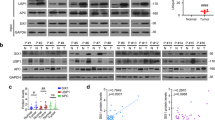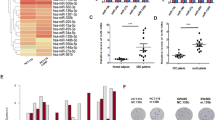Abstract
Considerable evidences have shown that autophagy has an important role in tumor chemoresistance. However, it is still unknown whether the lncRNA HULC (highly upregulated in liver cancer) is involved in autophagy and chemoresistance of hepatocellular carcinoma (HCC). In this study, we for the first time demonstrated that treatment with antitumor reagents such as oxaliplatin, 5-fluorouracil and pirarubicin (THP) dramatically induced HULC expression and protective autophagy. Silencing of HULC sensitized HCC cells to the three antitumor reagents via inhibiting protective autophagy. Ectopic expression of HULC elicited the autophagy of HCC cells through stabilizing silent information regulator 1 (Sirt1) protein. The investigation for the corresponding mechanism by which HULC stabilized Sirt1 revealed that HULC upregulated ubiquitin-specific peptidase 22 (USP22), leading to the decrease of ubiquitin-mediated degradation of Sirt1 protein by removing the conjugated polyubiquitin chains from Sirt1. Moreover, we found that miR-6825-5p, miR-6845-5p and miR-6886-3p could decrease the level of USP22 protein by binding to the 3′-untranlated region of USP22 mRNA. All the three microRNAs (miRNAs) were downregulated by HULC, which resulted in the elevation of USP22. In addition, we showed that the level of HULC was positively correlated with that of Sirt1 protein in human HCC tissues. Collectively, our data reveals that the pathway ‘HULC/USP22/Sirt1/ protective autophagy’ attenuates the sensitivity of HCC cells to chemotherapeutic agents, suggesting that this pathway may be a novel target for developing sensitizing strategy to HCC chemotherapy.
This is a preview of subscription content, access via your institution
Access options
Subscribe to this journal
Receive 50 print issues and online access
$259.00 per year
only $5.18 per issue
Buy this article
- Purchase on Springer Link
- Instant access to full article PDF
Prices may be subject to local taxes which are calculated during checkout








Similar content being viewed by others
References
El-Serag HB . Epidemiology of viral hepatitis and hepatocellular carcinoma. Gastroenterology 2012; 142: 1264–1273 e1261.
Ferlay J, Soerjomataram I, Dikshit R, Eser S, Mathers C, Rebelo M et al. Cancer incidence and mortality worldwide: sources, methods and major patterns in GLOBOCAN 2012. Int J Cancer 2015; 136: E359–E386.
Carew JS, Nawrocki ST, Cleveland JL . Modulating autophagy for therapeutic benefit. Autophagy 2007; 3: 464–467.
Song J, Qu Z, Guo X, Zhao Q, Zhao X, Gao L et al. Hypoxia-induced autophagy contributes to the chemoresistance of hepatocellular carcinoma cells. Autophagy 2009; 5: 1131–1144.
Klionsky DJ . Autophagy: from phenomenology to molecular understanding in less than a decade. Nat Rev Mol Cell Biol 2007; 8: 931–937.
Luo T, Fu J, Xu A, Su B, Ren Y, Li N et al. PSMD10/Gankyrin induces autophagy to promote tumor progression through cytoplasmic interaction with ATG7 and nuclear transactivation of ATG7 expression. Autophagy 2015; 12: 1355–1371.
Guo XL, Hu F, Zhang SS, Zhao QD, Zong C, Ye F et al. Inhibition of p53 increases chemosensitivity to 5-FU in nutrient-deprived hepatocarcinoma cells by suppressing autophagy. Cancer Lett 2014; 346: 278–284.
Ulitsky I, Bartel DP . lincRNAs: genomics, evolution, and mechanisms. Cell 2013; 154: 26–46.
Batista PJ, Chang HY . Long noncoding RNAs: cellular address codes in development and disease. Cell 2013; 152: 1298–1307.
Wang J, Liu X, Wu H, Ni P, Gu Z, Qiao Y et al. CREB up-regulates long non-coding RNA, HULC expression through interaction with microRNA-372 in liver cancer. Nucleic Acids Res 2010; 38: 5366–5383.
Hammerle M, Gutschner T, Uckelmann H, Ozgur S, Fiskin E, Gross M et al. Posttranscriptional destabilization of the liver-specific long noncoding RNA HULC by the IGF2 mRNA-binding protein 1 (IGF2BP1). Hepatology 2013; 58: 1703–1712.
Du Y, Kong G, You X, Zhang S, Zhang T, Gao Y et al. Elevation of highly up-regulated in liver cancer (HULC) by hepatitis B virus X protein promotes hepatoma cell proliferation via down-regulating p18. J Biol Chem 2012; 287: 26302–26311.
Cui M, Xiao Z, Wang Y, Zheng M, Song T, Cai X et al. Long noncoding RNA HULC modulates abnormal lipid metabolism in hepatoma cells through an miR-9-mediated RXRA signaling pathway. Cancer Res 2015; 75: 846–857.
Lu Z, Xiao Z, Liu F, Cui M, Li W, Yang Z et al. Long non-coding RNA HULC promotes tumor angiogenesis in liver cancer by up-regulating sphingosine kinase 1 (SPHK1). Oncotarget 2016; 7: 241–254.
Chen J, Zhang B, Wong N, Lo AW, To KF, Chan AW et al. Sirtuin 1 is upregulated in a subset of hepatocellular carcinomas where it is essential for telomere maintenance and tumor cell growth. Cancer Res 2011; 71: 4138–4149.
Peng L, Yuan Z, Li Y, Ling H, Izumi V, Fang B et al. Ubiquitinated sirtuin 1 (SIRT1) function is modulated during DNA damage-induced cell death and survival. J Biol Chem 2015; 290: 8904–8912.
Lin Z, Yang H, Kong Q, Li J, Lee SM, Gao B et al. USP22 antagonizes p53 transcriptional activation by deubiquitinating Sirt1 to suppress cell apoptosis and is required for mouse embryonic development. Mol Cell 2012; 46: 484–494.
Gao Z, Zhang J, Kheterpal I, Kennedy N, Davis RJ, Ye J . Sirtuin 1 (SIRT1) protein degradation in response to persistent c-Jun N-terminal kinase 1 (JNK1) activation contributes to hepatic steatosis in obesity. J Biol Chem 2011; 286: 22227–22234.
Wang K, Long B, Zhou LY, Liu F, Zhou QY, Liu CY et al. CARL lncRNA inhibits anoxia-induced mitochondrial fission and apoptosis in cardiomyocytes by impairing miR-539-dependent PHB2 downregulation. Nat Commun 2014; 5: 3596.
Lee IH, Cao L, Mostoslavsky R, Lombard DB, Liu J, Bruns NE et al. A role for the NAD-dependent deacetylase Sirt1 in the regulation of autophagy. Proc Natl Acad Sci USA 2008; 105: 3374–3379.
Hariharan N, Maejima Y, Nakae J, Paik J, Depinho RA, Sadoshima J . Deacetylation of FoxO by Sirt1 plays an essential role in mediating starvation-induced autophagy in cardiac myocytes. Circ Res 2010; 107: 1470–1482.
Song YM, Lee YH, Kim JW, Ham DS, Kang ES, Cha BS et al. Metformin alleviates hepatosteatosis by restoring SIRT1-mediated autophagy induction via an AMP-activated protein kinase-independent pathway. Autophagy 2015; 11: 46–59.
Shteingauz A, Boyango I, Naroditsky I, Hammond E, Gruber M, Doweck I et al. Heparanase enhances tumor growth and chemoresistance by promoting autophagy. Cancer Res 2015; 75: 3946–3957.
He J, Yu JJ, Xu Q, Wang L, Zheng JZ, Liu LZ et al. Downregulation of ATG14 by EGR1-MIR152 sensitizes ovarian cancer cells to cisplatin-induced apoptosis by inhibiting cyto-protective autophagy. Autophagy 2015; 11: 373–384.
Qiu G, Li X, Che X, Wei C, He S, Lu J et al. SIRT1 is a regulator of autophagy: Implications in gastric cancer progression and treatment. FEBS Lett 2015; 589: 2034–2042.
Bae HJ, Noh JH, Kim JK, Eun JW, Jung KH, Kim MG et al. MicroRNA-29c functions as a tumor suppressor by direct targeting oncogenic SIRT1 in hepatocellular carcinoma. Oncogene 2014; 33: 2557–2567.
Chen HC, Jeng YM, Yuan RH, Hsu HC, Chen YL . SIRT1 promotes tumorigenesis and resistance to chemotherapy in hepatocellular carcinoma and its expression predicts poor prognosis. Ann Surg Oncol 2012; 19: 2011–2019.
Zhang XY, Varthi M, Sykes SM, Phillips C, Warzecha C, Zhu W et al. The putative cancer stem cell marker USP22 is a subunit of the human SAGA complex required for activated transcription and cell-cycle progression. Mol Cell 2008; 29: 102–111.
Schrecengost RS, Dean JL, Goodwin JF, Schiewer MJ, Urban MW, Stanek TJ et al. USP22 regulates oncogenic signaling pathways to drive lethal cancer progression. Cancer Res 2014; 74: 272–286.
Tang B, Tang F, Li B, Yuan S, Xu Q, Tomlinson S et al. High USP22 expression indicates poor prognosis in hepatocellular carcinoma. Oncotarget 2015; 6: 12654–12667.
Li L, Osdal T, Ho Y, Chun S, McDonald T, Agarwal P et al. SIRT1 activation by a c-MYC oncogenic network promotes the maintenance and drug resistance of human FLT3-ITD acute myeloid leukemia stem cells. Cell Stem Cell 2014; 15: 431–446.
Armour SM, Bennett EJ, Braun CR, Zhang XY, McMahon SB, Gygi SP et al. A high-confidence interaction map identifies SIRT1 as a mediator of acetylation of USP22 and the SAGA coactivator complex. Mol Cell Biol 2013; 33: 1487–1502.
Bartel DP . MicroRNAs: target recognition and regulatory functions. Cell 2009; 136: 215–233.
Khorshid M, Hausser J, Zavolan M, van Nimwegen E . A biophysical miRNA-mRNA interaction model infers canonical and noncanonical targets. Nat Methods 2013; 10: 253–255.
Helwak A, Kudla G, Dudnakova T, Tollervey D . Mapping the human miRNA interactome by CLASH reveals frequent noncanonical binding. Cell 2013; 153: 654–665.
Li SP, Xu HX, Yu Y, He JD, Wang Z, Xu YJ et al. LncRNA HULC enhances epithelial-mesenchymal transition to promote tumorigenesis and metastasis of hepatocellular carcinoma via the miR-200a-3p/ZEB1 signaling pathway. Oncotarget 2016; 7: 42431–42446.
Hu C, Liu D, Zhang Y, Lou G, Huang G, Chen B et al. LXRalpha-mediated downregulation of FOXM1 suppresses the proliferation of hepatocellular carcinoma cells. Oncogene 2014; 33: 2888–2897.
Zhou P, Huang G, Zhao Y, Zhong D, Xu Z, Zeng Y et al. MicroRNA-363-mediated downregulation of S1PR1 suppresses the proliferation of hepatocellular carcinoma cells. Cell Signal 2014; 26: 1347–1354.
Li Q, Fang Y, Zhu P, Ren CY, Chen H, Gu J et al. Burkholderia pseudomallei survival in lung epithelial cells benefits from miRNA-mediated suppression of ATG10. Autophagy 2015; 11: 1293–1307.
Hu C, Ni Z, Li BS, Yong X, Yang X, Zhang JW et al. hTERT promotes the invasion of gastric cancer cells by enhancing FOXO3a ubiquitination and subsequent ITGB1 upregulation. Gut 2015; 66: 31–42.
Acknowledgements
This work was supported by the National Natural Science Foundation of China (81672377, 31470066, 81472291 and 81272690).
Author information
Authors and Affiliations
Corresponding authors
Ethics declarations
Competing interests
The authors declare no conflict of interest.
Additional information
Supplementary Information accompanies this paper on the Oncogene website
Supplementary information
Rights and permissions
About this article
Cite this article
Xiong, H., Ni, Z., He, J. et al. LncRNA HULC triggers autophagy via stabilizing Sirt1 and attenuates the chemosensitivity of HCC cells. Oncogene 36, 3528–3540 (2017). https://doi.org/10.1038/onc.2016.521
Received:
Revised:
Accepted:
Published:
Issue Date:
DOI: https://doi.org/10.1038/onc.2016.521
This article is cited by
-
Long noncoding RNA H19: functions and mechanisms in regulating programmed cell death in cancer
Cell Death Discovery (2024)
-
Bone marrow mesenchymal stem cell-derived exosomal lncRNA KLF3-AS1 stabilizes Sirt1 protein to improve cerebral ischemia/reperfusion injury via miR-206/USP22 axis
Molecular Medicine (2023)
-
Loss of 5-hydroxymethylcytosine induces chemotherapy resistance in hepatocellular carcinoma via the 5-hmC/PCAF/AKT axis
Cell Death & Disease (2023)
-
Long non-coding RNAs: controversial roles in drug resistance of solid tumors mediated by autophagy
Cancer Chemotherapy and Pharmacology (2023)
-
Identification of biomarkers of hepatocellular carcinoma gene prognosis based on the immune-related lncRNA signature of transcriptome data
Functional & Integrative Genomics (2023)



